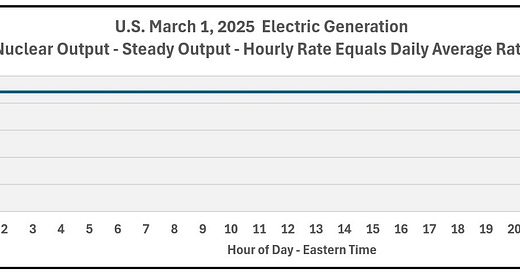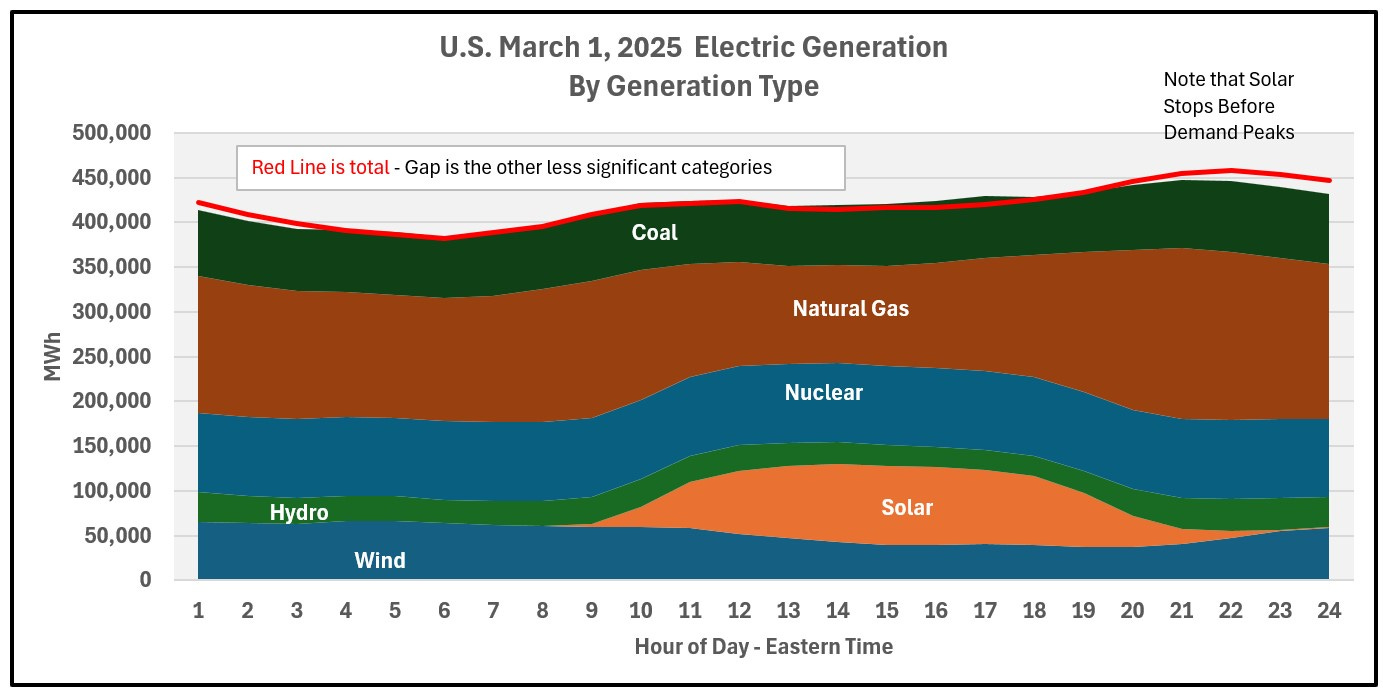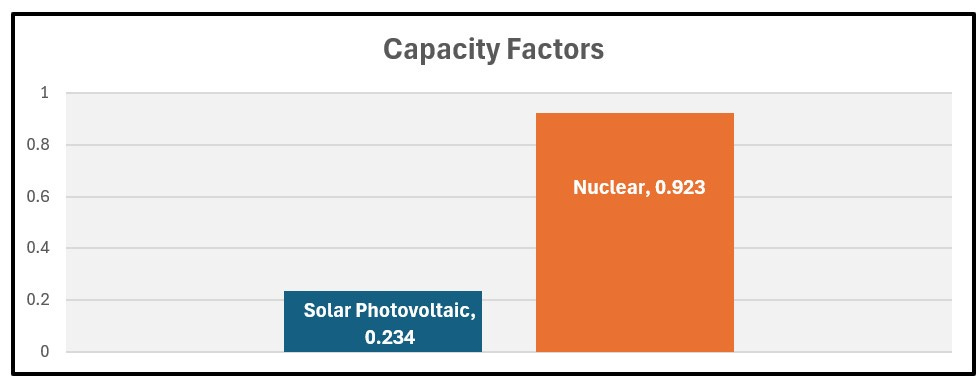On March 1, 2025, U.S. solar power nearly matched nuclear output for three hours—a milestone for clean energy. Yet, this fleeting triumph highlights a persistent challenge: can solar’s bursts of power become as reliable as nuclear’s steady hum? Let’s explore the data to understand what this moment means for our energy future.
Nuclear vs. Solar: A Tale of Stability and Surges
Nuclear: The Steady Workhorse
Nuclear plants are the grid’s backbone, delivering a consistent ~88,000 megawatt-hours (MWh) of electricity every hour on March 1, 2025, per U.S. Energy Information Administration (EIA) data (Eastern Standard Time). A megawatt-hour is enough energy to power ~330 homes for an hour. The graph below shows nuclear’s flat line—reliable power, day or night, rain or shine.
Solar: Bright Peaks, Dark Valleys
Solar power, by contrast, is a rollercoaster. On March 1, it produced no electricity from midnight to 9 AM. Output climbed from 9 AM, peaking at ~87,000 MWh from 1 PM to 4 PM, then dropped to zero by 11 PM. Its daily average? Just 32,249 MWh. Solar shines when the sun does but fades at night or under clouds.
The 3-Hour Triumph: Solar Meets Nuclear
For three hours, solar nearly equaled nuclear, a win for renewables that cut fuel costs and emissions during peak daylight. But as families returned home, cranking appliances after 5 PM, solar’s output plummeted, leaving the grid to rely on other sources until morning. This brief overlap raises a question: can solar scale up without sacrificing reliability? Emerging battery storage could help, but current systems last hours, not days, limiting solar’s ability to provide consistent power.
The Grid’s Balancing Act
Natural Gas: The Flexible Fallback
The grid needs a “baseload”—constant power to meet minimum demand—and flexible sources to handle spikes, like evening appliance use. Nuclear and coal provide baseload, but when solar fades, natural gas steps in. The graph below shows gas ramping up after 3 PM to stabilize the grid as solar and wind dip.
This flexibility comes at a cost. Rapidly cycling gas plants wears equipment, increasing maintenance expenses—costs often passed to consumers. In March 2025, gas adjusted hourly to balance renewable swings, ensuring reliability but driving up grid operation expenses.
Capacity and Scalability
A power plant’s “capacity factor” measures how often it runs at full potential, like a car’s time at top speed. Nuclear averages 92.3% annually, per EIA, meaning a 100-megawatt plant delivers ~92 megawatts on average. Solar, dependent on sunlight, averages 23.4%, so a 100-megawatt solar farm produces ~23 megawatts yearly, and only during the day.
Solar’s installed capacity is growing, but its actual output remains a fraction of its potential. This explains why tech giants like Microsoft, powering AI data centers that need 24/7 electricity, are investing in nuclear. For example, Microsoft signed a 2024 deal to restart a nuclear reactor for its data centers, prioritizing reliability over solar’s intermittency.
The Road Ahead: Balancing Clean and Reliable Power
Solar’s growth is impressive, fueled by declining panel costs and policies like the Inflation Reduction Act, which offers tax credits for renewables. But its variability demands backup systems, increasing grid complexity. Battery storage could smooth solar’s peaks, but high costs remain a hurdle. Nuclear, meanwhile, is gaining traction, with small modular reactors promising scalable, low-carbon power. Natural gas’s flexibility remains critical but costly.
As AI data centers and electric vehicles drive electricity demand, the U.S. needs a grid that’s both clean and dependable. Solar will play a role, but nuclear’s reliability and gas’s adaptability are proving essential. Policymakers must balance these realities to keep energy affordable.
Notes:
All data presented here represents downloads of data tables from EIA and then presented in displays that I prepared.










Good for solar, EXCEPT solar power does not run motors, 40% of grid load. See https://www.linkedin.com/posts/roberthargraves_40-of-us-electricity-powers-electric-motors-activity-7321501885541072896-ivpM?utm_source=share&utm_medium=member_desktop&rcm=ACoAAAGg2jwB-LgQQUNP_HdxQ5Qo6PAGA84mQK0